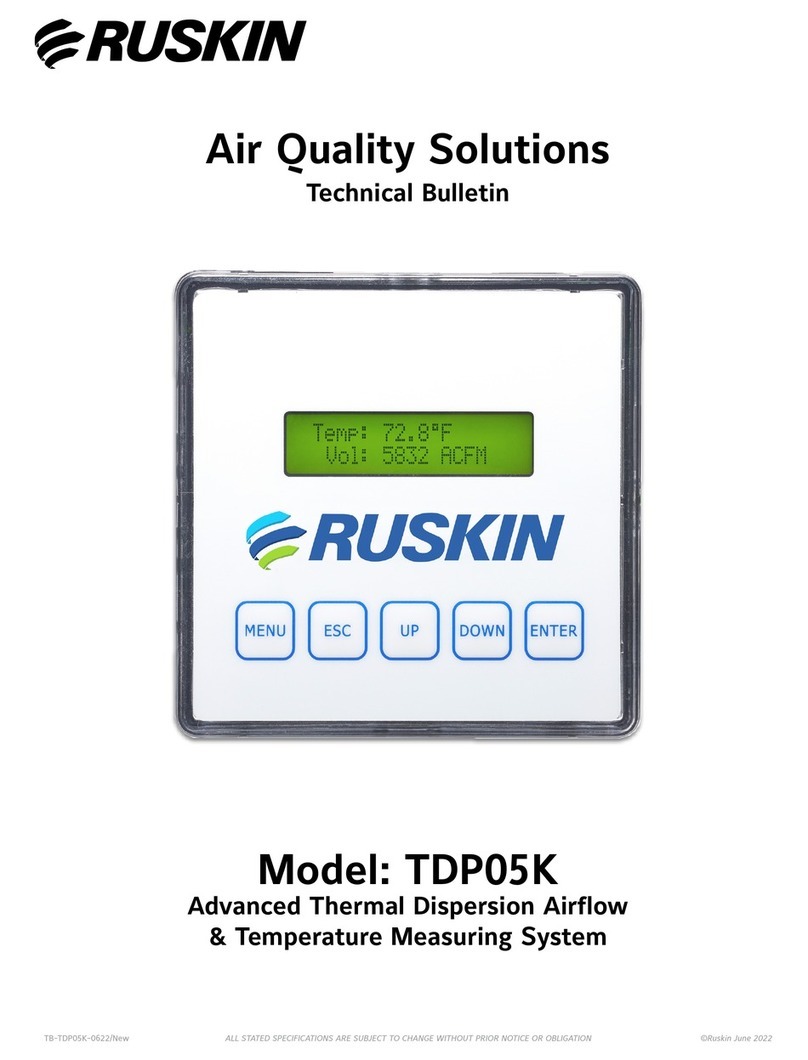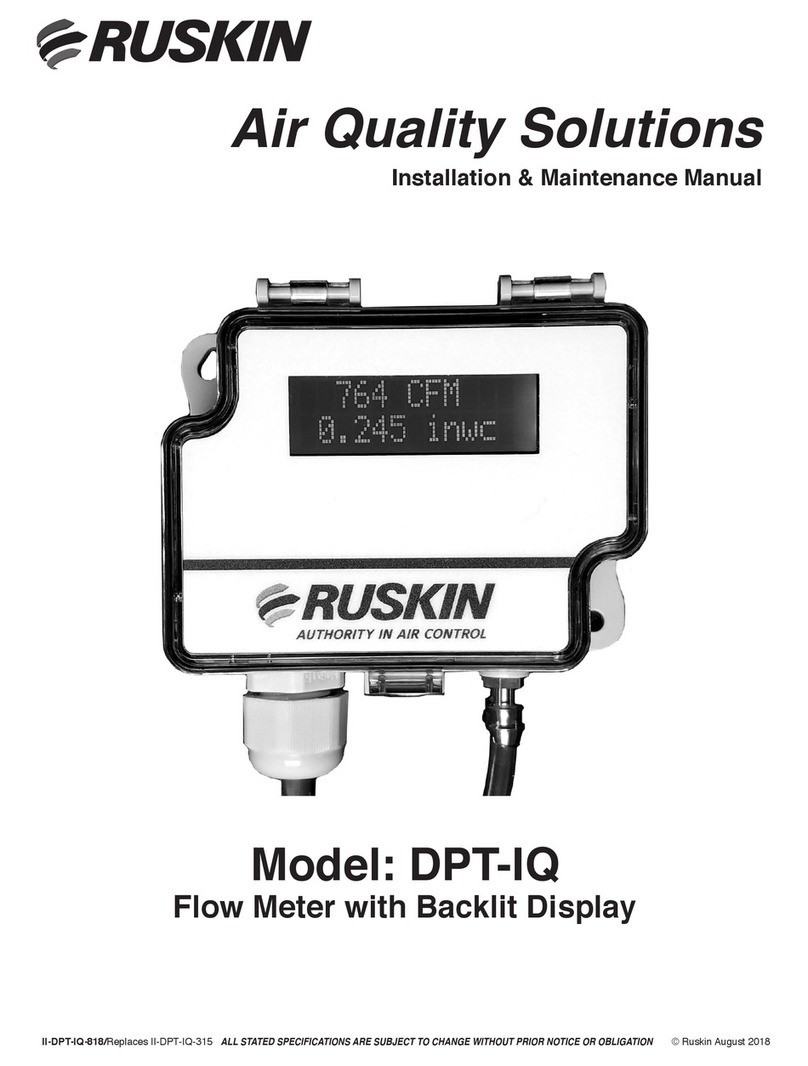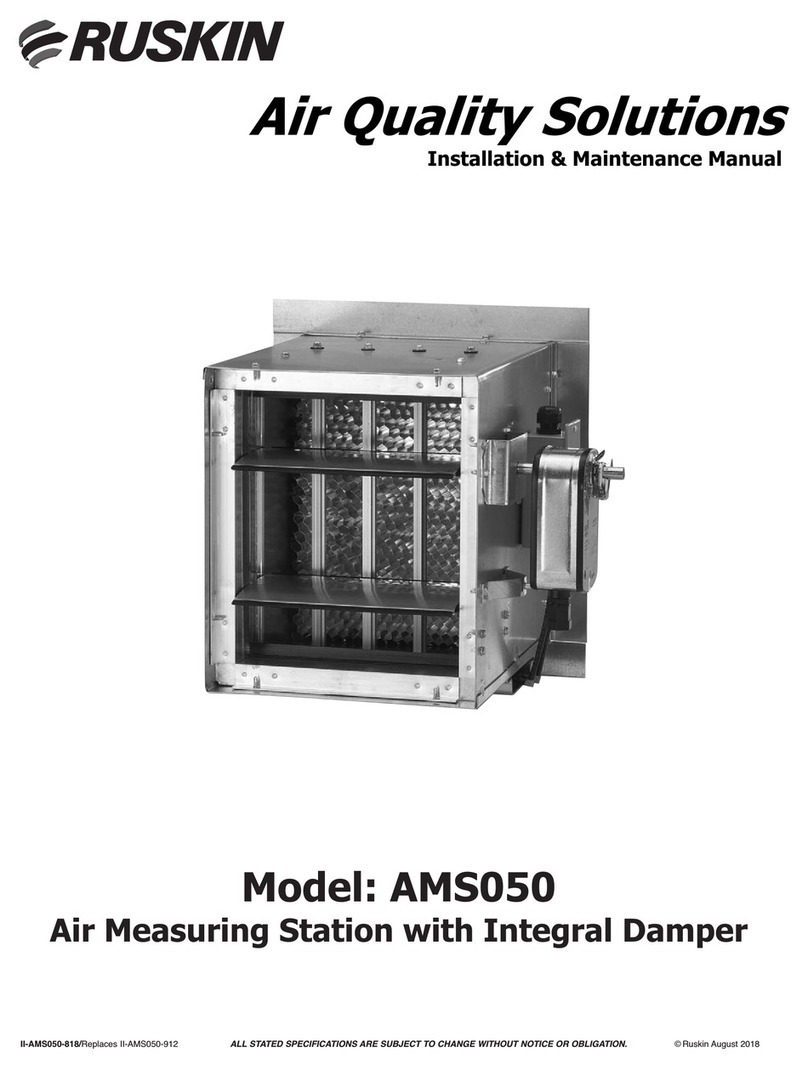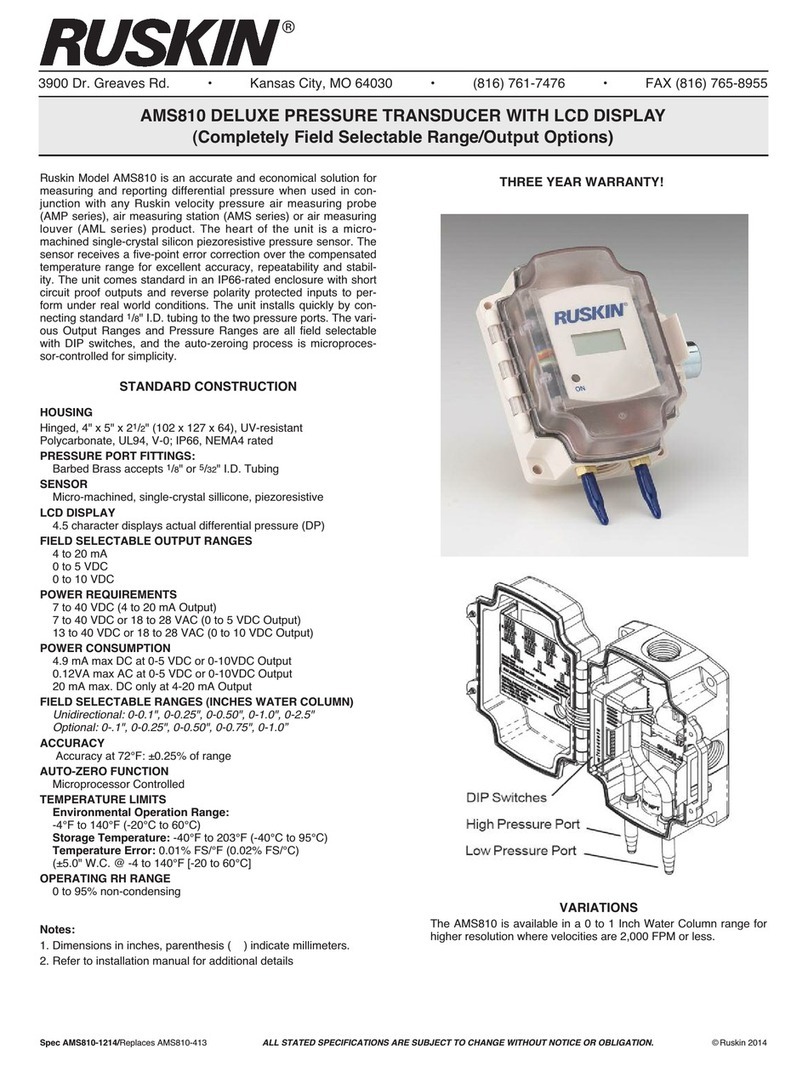
Locating the Fan Inlet Sensors on
centrifugal Forward Curve Fans
Mounting the Inlet Sensors
Inspect the fan inlet opening to ensure no
obstructions or irregularities interfere with installation
of the sensors. Install the two fan inlet sensors
opposite one another within the fan inlet bell. Place
the sensor housing at or near the highest restriction
point of the fan inlet as possible. Be careful to not
bend or touch the thermistors while installing.
Sensors should be placed at the 12:00 o’clock and
6:00 o’clock positions, directly opposite one another
in a similar fashion for fans with the air exiting on the
right or left of the housing. See Figure 1.
Sensors should be placed at the 3:00 o’clock and
9:00 o’clock positions, directly opposite one another
for fans with the air exiting on the top or bottom of
the fan housing. See Figure 2.
On dual inlet fans, install two sensor circuits within
each fan inlet bell. Place the sensor at or near the
highest restriction point of each inlet as possible.
Use the supplied pan head, self-drilling fasteners
(included in parts bag) to fasten the fan inlet sensor
to the inlet bell. Use nylon cable clamps (included in
parts bag) to secure RJ45 cable to the inlet bell.
If the fan has a shallow inlet bell, use a box knife or
other utility knife to remove the Air Leaving Wedge,
leaving the primary sensor housing (containing the
sensor circuit) and the Air Entering Wedge. Use the
mounting hole on the Primary Sensor Housing if you
remove the Air Leaving Wedge.
Locating the Fan Inlet Sensors on Forward
Curve Fans
Inspect the fan inlet opening to ensure no
obstructions or irregularities interfere with installation
of the sensors. Install the two fan inlet sensors
opposite one another within the fan inlet bell. Place
the sensor housing at or near the highest restriction
point of the fan inlet as possible.
Sensors should be placed at the 12:00 o'clock and
6:00 o'clock positions, directly opposite one another
in a similar fashion for fans with the air exiting on the
right or left of the housing. See Figure 1.
Sensors should be placed at the 3:00 o'clock and
9:00 o'clock positions, directly opposite one another
for fans with the air exiting on the top or bottom of the
housing. See Figure 2.
On dual inlet fans, install two sensor circuits within
each fan inlet bell. Place the sensor housing at or
near the highest restriction point of each inlet as
possible.
Figure 1: Sensor Mounting
Figure 2: Sensor Mounting
Mounting the Fan Inlet Sensors
Use the supplied pan head, self-drilling fasteners
(included in parts bag) to fasten the fan inlet sensor to
the inlet bell.
If the fan has a shallow inlet bell, use a box knife or
other utility knife to remove the Air Leaving Wedge,
leaving the primary sensor housing (containing the
sensor circuit) and the Air Entering Wedge. Use the
mounting hole on the Primary Sensor Housing if you
remove the Air Leaving Wedge.
Figure 3: Fan Inlet Sensor
Note: Ensure that the airflow arrow is pointed in the
correct direction.
Figure 4: Fan Inlet Sensor Dimensions, in. (mm)
RUSKIN EFAMS Thermal Dispersion Airflow Measuring System Installation Instructions
Figure 1: Sensor Mounting
Figure 2: Sensor Mounting
RUSKIN EFAMS THERMAL DISPERSION AIRFLOW MEASURING SYSTEM INSTALLATION INSTRUCTIONS
4
Locating the Fan Inlet Sensors on Forward
Curve Fans
Inspect the fan inlet opening to ensure no
obstructions or irregularities interfere with installation
of the sensors. Install the two fan inlet sensors
opposite one another within the fan inlet bell. Place
the sensor housing at or near the highest restriction
point of the fan inlet as possible.
Sensors should be placed at the 12:00 o'clock and
6:00 o'clock positions, directly opposite one another
in a similar fashion for fans with the air exiting on the
right or left of the housing. See Figure 1.
Sensors should be placed at the 3:00 o'clock and
9:00 o'clock positions, directly opposite one another
for fans with the air exiting on the top or bottom of the
housing. See Figure 2.
On dual inlet fans, install two sensor circuits within
each fan inlet bell. Place the sensor housing at or
near the highest restriction point of each inlet as
possible.
Figure 1: Sensor Mounting
Figure 2: Sensor Mounting
Mounting the Fan Inlet Sensors
Use the supplied pan head, self-drilling fasteners
(included in parts bag) to fasten the fan inlet sensor to
the inlet bell.
If the fan has a shallow inlet bell, use a box knife or
other utility knife to remove the Air Leaving Wedge,
leaving the primary sensor housing (containing the
sensor circuit) and the Air Entering Wedge. Use the
mounting hole on the Primary Sensor Housing if you
remove the Air Leaving Wedge.
Figure 3: Fan Inlet Sensor
Note: Ensure that the airflow arrow is pointed in the
correct direction.
Figure 4: Fan Inlet Sensor Dimensions, in. (mm)
RUSKIN EFAMS Thermal Dispersion Airflow Measuring System Installation Instructions
Locating the Fan Inlet Sensors on Forward
Curve Fans
Inspect the fan inlet opening to ensure no
obstructions or irregularities interfere with installation
of the sensors. Install the two fan inlet sensors
opposite one another within the fan inlet bell. Place
the sensor housing at or near the highest restriction
point of the fan inlet as possible.
Sensors should be placed at the 12:00 o'clock and
6:00 o'clock positions, directly opposite one another
in a similar fashion for fans with the air exiting on the
right or left of the housing. See Figure 1.
Sensors should be placed at the 3:00 o'clock and
9:00 o'clock positions, directly opposite one another
for fans with the air exiting on the top or bottom of the
housing. See Figure 2.
On dual inlet fans, install two sensor circuits within
each fan inlet bell. Place the sensor housing at or
near the highest restriction point of each inlet as
possible.
Figure 1: Sensor Mounting
Figure 2: Sensor Mounting
Mounting the Fan Inlet Sensors
Use the supplied pan head, self-drilling fasteners
(included in parts bag) to fasten the fan inlet sensor to
the inlet bell.
If the fan has a shallow inlet bell, use a box knife or
other utility knife to remove the Air Leaving Wedge,
leaving the primary sensor housing (containing the
sensor circuit) and the Air Entering Wedge. Use the
mounting hole on the Primary Sensor Housing if you
remove the Air Leaving Wedge.
Figure 3: Fan Inlet Sensor
Note: Ensure that the airflow arrow is pointed in the
correct direction.
Figure 4: Fan Inlet Sensor Dimensions, in. (mm)
RUSKIN EFAMS Thermal Dispersion Airflow Measuring System Installation Instructions
Figure 3: Fan Inlet Sensor
Note: Ensure that the airow arrow is pointed in the
correct direction.
Figure 4: Fan Inlet Sensor Dimensions, in. (mm)
120
(3048)
13/8(35)
1 (25)
31/8(79)
1/2(13)
Airflow
Primary
Sensor
Housing
Air
Leaving
Wedge
Air
Entering
Wedge
Ambient
Thermistor
Heated
Thermistor
Remove piece for shallow
inlet bell installations







































